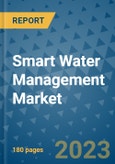The world is facing a critical water scarcity problem, with projections indicating that two-thirds of the global population will experience water shortages by 2025. Water scarcity can lead to numerous issues, including droughts, reduced food production, lower economic growth, and challenges in the industrial sector. In response to these challenges, smart water management is emerging as a key solution to optimize water resources efficiently and mitigate the impact of water scarcity.
Smart Water Management Solutions to Drive Efficiency
Smart water management involves the use of technology to collect data on water usage, predict water needs, and allocate resources effectively. By adopting smart water management solutions, municipalities and businesses can better understand their water usage patterns and implement changes to improve efficiency. For instance, with real-time data on water consumption, cities can adjust their water usage during different seasons to optimize resources and reduce wastage.Commercial and Industrial Sectors Leading Adoption
The industrial and commercial sectors are among the highest water consumers globally. To manage their water usage effectively, these sectors are increasingly turning to smart water management solutions. The use of sensors and analytics enables these sectors to identify inefficiencies and optimize water usage, resulting in reduced water consumption and cost savings. A recent study found that 82% of industrial and commercial companies either use or plan to use smart water management solutions in the next five years, primarily to reduce water usage and save money on water bills.Government Initiatives and Increasing Urbanization to Boost Market Growth
As rapid urbanization continues, the demand for efficient water management systems is growing. Water utilities are under pressure to meet the needs of a larger population while maintaining high-quality water supply. In response, governments are implementing regulations and laws focused on water conservation and sustainable living. The adoption of smart water management technologies is a key strategy to achieve these goals, leading to a surge in demand for such solutions.Asia Pacific Leading the Way
The Asia Pacific region, home to approximately 60% of the global population, is witnessing rapid industrialization and urbanization. Consequently, the demand for water is rising rapidly, necessitating the adoption of smart water management solutions. Countries in the Asia Pacific are investing in advanced technologies such as data analytics, remote monitoring, and real-time leak detection systems to optimize water usage and distribution.Challenges and Opportunities
Though smart water management holds immense potential, challenges remain. Widespread adoption of the concept among policy-makers and stakeholders is necessary. Improved data collection, information management, and decision-making frameworks are crucial to its successful implementation. However, as countries increasingly invest in smart water management, the market is projected to grow at a healthy CAGR in the years to come.Key Players Shaping the Smart Water Management Market
Leading players in the smart water management market include IBM, Siemens, ABB, Schneider Electric, Honeywell Elster, Itron, SUEZ, Landis+Gyr, Oracle, and more. These companies are driving innovation through new technology launches, strategic partnerships, and continuous advancements in the field of smart water management.Table of Contents
1. Executive Summary
2. Market Overview
3. Global Smart Water Management Market Outlook, 2018-2030
4. North America Smart Water Management Market Outlook, 2018-2030
5. Europe Smart Water Management Market Outlook, 2018-2030
6. Asia Pacific Smart Water Management Market Outlook, 2018-2030
7. Latin America Smart Water Management Market Outlook, 2018 - 2030
8. Middle East & Africa Smart Water Management Market Outlook, 2018-2030
9. Competitive Landscape
10. Appendix
Companies Mentioned
- Siemens AG
- ABB Ltd.
- IBM Corporation
- Schneider Electric
- Oracle Corporation
- Suez SA
- Syrinix Limited
- i2O Water Ltd.
- Landis+Gyr
- Trimble Water
- Xenius
- Xylem








